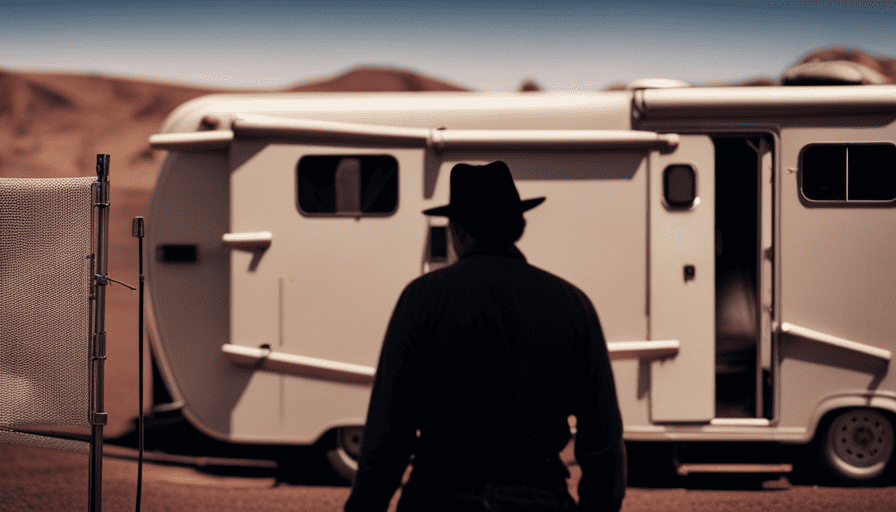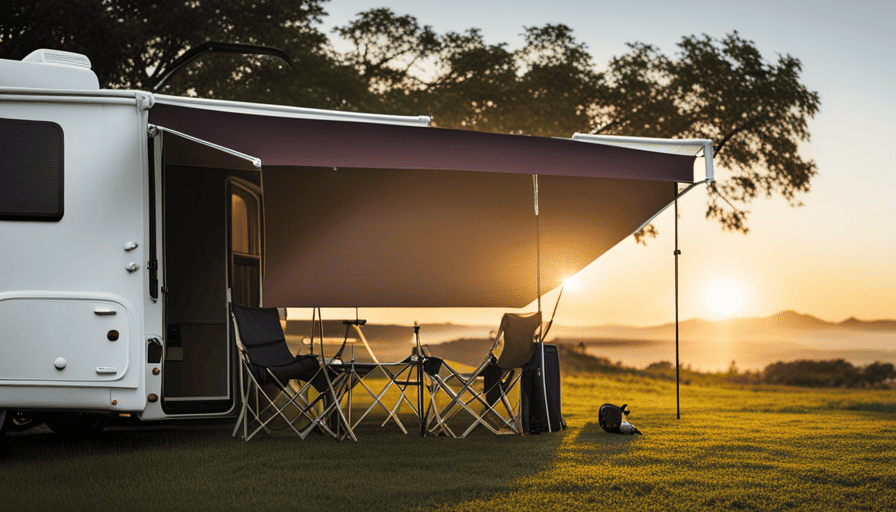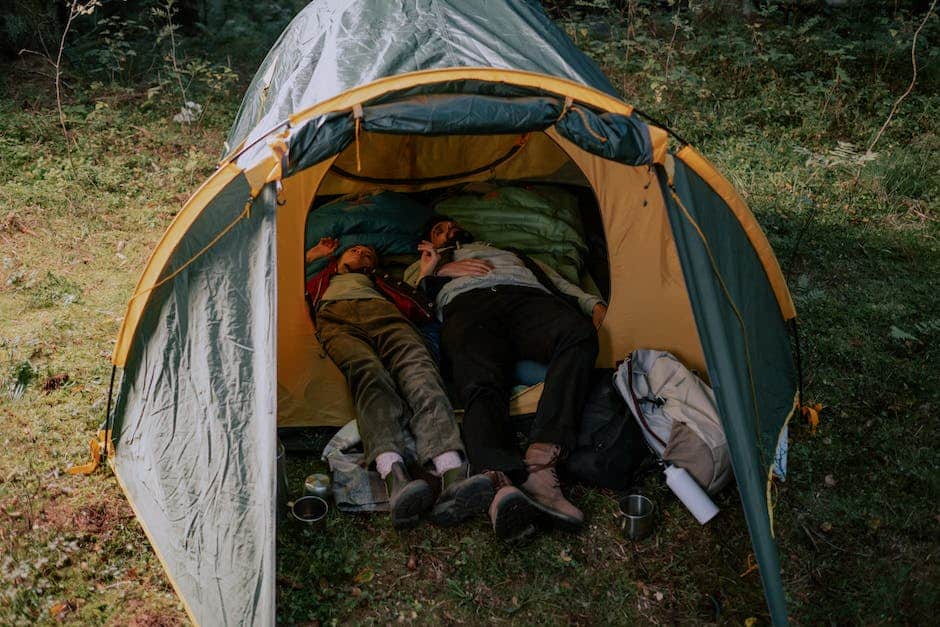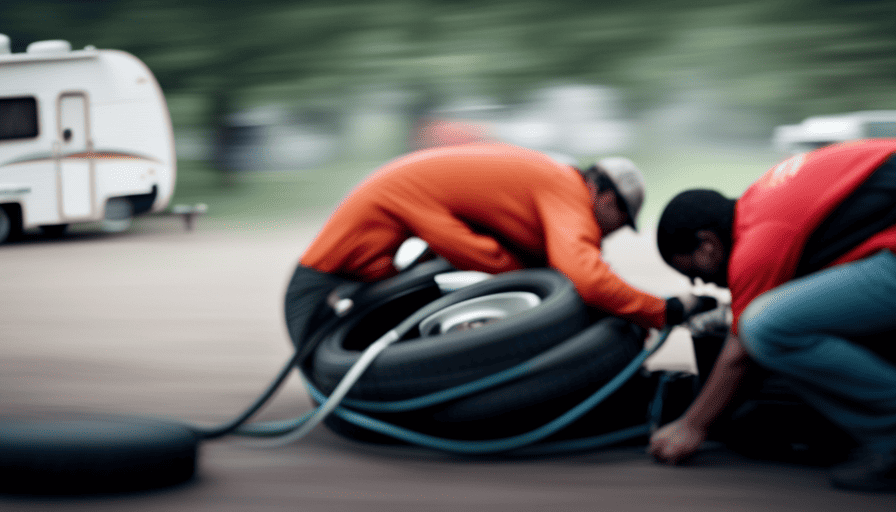Have you ever been camping and realized that your camper is not level? Dealing with a tilted or shaky camper can be frustrating and uncomfortable. But fear not! I have a foolproof method for leveling your camper using stabilizer jacks that I am eager to share with you.
Leveling your camper is crucial for a smooth and enjoyable camping experience. It not only ensures your comfort inside the camper but also prevents any potential damage to its structure.
With the help of stabilizer jacks, you can easily achieve a stable and level camper in no time.
In this article, I will guide you through the step-by-step process of leveling your camper with stabilizer jacks. We will cover everything from gathering the necessary tools and equipment to testing the stability of your camper.
So let’s get started and make sure your next camping adventure is as comfortable as can be!
Key Takeaways
- Leveling a camper with stabilizer jacks is important for comfort and preventing damage.
- Maintaining and inspecting stabilizer jacks regularly is crucial for their effectiveness.
- Finding a suitable location for parking the camper is essential to ensure a level surface.
- Using a bubble level or leveling app helps in achieving precise leveling on uneven ground.
Understand the Importance of Leveling Your Camper
You don’t want to wake up in the middle of the night to find yourself rolling off your bed because your camper wasn’t properly leveled. Ensuring that your camper is level is an essential part of camper maintenance. Not only does it provide a more comfortable experience while inside, but it also prevents any damage to the camper itself.
Leveling your camper is especially important when using appliances such as the refrigerator, as they require a level surface to operate efficiently.
One of the most common leveling mistakes is relying solely on your camper’s built-in leveling system. While these systems can be useful, they’re not always accurate. It’s essential to use a level and check the camper’s levelness manually.
To level your camper properly, you’ll need a few tools and equipment. These include leveling blocks, a level, and stabilizer jacks. The leveling blocks are used to raise or lower the camper to the desired level, while the level ensures accuracy. Stabilizer jacks are used to provide additional stability once the camper is level.
Now that you understand the importance of leveling your camper and the common leveling mistakes, it’s time to gather the necessary tools and equipment to begin the leveling process.
Gather the Necessary Tools and Equipment
First, grab a sturdy wrench to tighten the bolts and prevent any wobbling during your camping adventure. Imagine the peace of mind knowing that your camper is securely stabilized. Stabilizer jacks are crucial for maintaining the stability of your camper, especially on uneven terrain. To ensure their effectiveness, regular maintenance is necessary.
Inspect the jacks for any signs of wear and tear, such as rust or loose bolts. Lubricate the moving parts to keep them functioning smoothly. If you encounter any issues, consider purchasing replacement parts or seeking professional assistance.
In addition to traditional stabilizer jacks, there are alternative options available. Scissor jacks, for example, provide similar stability but are more compact and lightweight. They are easier to install and remove, making them convenient for frequent travelers. Electric stabilizer jacks offer the ultimate convenience, as they can be operated with the push of a button. However, they require a power source and may be more expensive.
Now that you’ve gathered the necessary tools and equipment, it’s time to find a suitable location for leveling your camper.
Find a Suitable Location for Leveling
Once you’ve gathered all the necessary tools and equipment, it’s time to scout for the perfect spot to ensure a smooth and enjoyable camping experience.
When it comes to leveling a camper on uneven terrain, there are a few tips to keep in mind. First and foremost, it’s important to find a location that is relatively flat and free from any large rocks or debris that could interfere with the stabilization process.
One common mistake to avoid is choosing a spot that is too close to a slope or incline. This can make it difficult to achieve a level position and may put unnecessary strain on your stabilizer jacks. Additionally, be mindful of any potential hazards such as tree roots or uneven ground that could cause instability.
When scouting for a suitable location, consider using a leveling tool or app to help determine the slope of the ground. This will give you a better idea of how much leveling you will need to do and can prevent any surprises once you start setting up.
Finding the right spot to level your camper is crucial for a successful camping experience. By following these tips and avoiding common mistakes, you can ensure a stable and safe setup. Now that you’ve found the perfect location, let’s move on to the next step of parking your camper on a level surface.
Park Your Camper on a Level Surface
As you glide your camper onto the serene and steady embrace of a perfectly balanced surface, a sense of tranquility washes over you, knowing that your oasis of relaxation is securely anchored.
Finding level ground is crucial for proper camper stabilization. Before parking your camper, it’s important to locate a level surface to prevent any tilting or rocking. This can be achieved by using a leveling tool or a smartphone app specifically designed for this purpose.
Once you have identified a flat area, it’s time to park your camper. Begin by slowly maneuvering your vehicle onto the level ground, ensuring that all wheels are aligned with the surface. If the ground is slightly uneven, you can use leveling blocks to raise the low side of your camper. These blocks can be stacked and placed under the tires on the low side, gradually leveling the camper.
Once you have parked your camper on a level surface, you’re ready to engage the stabilizer jacks, which will provide additional support and minimize any movement.
Engage the Stabilizer Jacks
To ensure a smooth and enjoyable camping experience, it’s essential that you secure your getaway haven by engaging the sturdy support system underneath. Stabilizer jacks play a crucial role in leveling your camper and providing stability while you’re parked. Let’s discuss the benefits of using stabilizer jacks for camper leveling as well as some tips for maintaining and caring for them.
Using stabilizer jacks offers several benefits. Firstly, they help distribute the weight of your camper evenly, preventing it from tilting or rocking while you’re inside. This ensures a comfortable and safe environment for you and your fellow campers. Secondly, stabilizer jacks reduce the stress on your camper’s frame and suspension, making it less likely to experience damage. Additionally, they minimize the movement caused by wind or people walking inside the camper, enhancing your overall camping experience.
To maintain and care for your stabilizer jacks, regularly inspect them for any signs of wear or damage. Keep them clean and lubricated to prevent rust and ensure smooth operation. It’s also important to check the bolts and tighten them if necessary. If you notice any issues, promptly address them to avoid further complications.
Now that we’ve discussed the benefits and maintenance of stabilizer jacks, let’s move on to the next step: extending the jacks to reach the ground. This will further stabilize your camper and provide a solid foundation for your camping adventure.
Extend the Jacks to Reach the Ground
Extend the jacks all the way down to the ground for maximum stability and a solid base for your camping experience. To stabilize your camper, it’s crucial to extend the jacks until they firmly reach the ground. This will ensure that your camper is level and secure, preventing any unwanted movement or instability.
Start by locating the stabilizer jacks on your camper. Typically, they’re located near each corner of the camper’s frame. Use a crank or an electric drill with a jack attachment to extend the jacks. Rotate the crank or use the drill in a clockwise motion to lower the jacks until they make firm contact with the ground.
Make sure to extend all the jacks evenly to distribute the weight of the camper properly. This will prevent any tilting or leaning, ensuring a level surface for your camping experience. Once the jacks are fully extended and touching the ground, you can proceed to the next step of using a bubble level to ensure proper leveling.
Using a bubble level will let you check if your camper is perfectly level. This step is essential for a comfortable camping experience and to prevent any issues with appliances, doors, or windows. By extending the jacks and then using a bubble level, you can achieve the optimal leveling for your camper.
Extending the jacks to reach the ground is a crucial step to stabilize your camper and provide a solid base. Once the jacks are fully extended, you can move on to using a bubble level to ensure proper leveling.
Use a Bubble Level to Ensure Proper Leveling
Using a bubble level will guarantee that your camping experience is absolutely flawless. It’s essential to have a level camper to ensure stability and comfort. Here are some tips for leveling a camper on uneven ground using a digital level for precise leveling:
- Place the bubble level on a flat surface inside your camper, such as a countertop or table.
- Adjust the stabilizer jacks on each corner of the camper to raise or lower the desired side until the bubble is centered.
- Use a flashlight to check the level from different angles and make any necessary adjustments.
Repeat this process for each corner until your camper is perfectly level.
By using a digital level, you can achieve precise leveling, preventing any discomfort or damage caused by an unlevel camper. It’s important to take your time and be patient while leveling, especially on uneven ground.
Now that your camper is level, it’s time to adjust the stabilizer jacks as needed. This will ensure that your camper remains stable and secure throughout your camping trip.
Adjust the Stabilizer Jacks as Needed
Once the camper is properly leveled, it’s crucial to make necessary adjustments to the stabilizer jacks for added stability and security during your camping trip. Common mistakes in leveling campers can lead to an unstable and uncomfortable camping experience.
To avoid these mistakes, follow these tips for maintaining stabilizer jacks.
Firstly, ensure that the stabilizer jacks are fully extended and in contact with the ground. This will provide maximum support and prevent any unnecessary movement. Use a wrench to tighten the jacks securely, but be careful not to overtighten, as this can damage the jacks or the camper’s frame.
Next, check the level of the camper using a bubble level. If the camper is not level, adjust the stabilizer jacks accordingly. Raise or lower individual jacks as needed to achieve a level position. Remember to check the level again after making adjustments to ensure accuracy.
Additionally, it’s important to periodically inspect the stabilizer jacks for any signs of wear or damage. Look for any loose bolts or cracks in the jacks’ mechanisms. If any issues are found, address them promptly to prevent further damage and maintain the stability of your camper.
By properly adjusting and maintaining the stabilizer jacks, you can ensure a stable and secure camping experience. Once the stabilizer jacks are in place, it’s time to test the stability of your camper before moving on to the next step.
Test the Stability of Your Camper
To ensure a secure and comfortable camping experience, it’s time to put your camper’s stability to the test. Testing the stability of your camper is crucial before settling in for the night. By doing so, you can identify any potential issues and address them immediately.
Start by walking around the camper, checking for any noticeable tilting or shifting. This visual inspection will give you an initial idea of the stability of your camper.
Next, it’s time to test the stability further by using camper leveling techniques. One effective method is to use a bubble level. Place it on a countertop or table inside the camper and check if it indicates a level surface. If not, adjust the stabilizer jacks accordingly until the bubble is centered.
Additionally, you can place small levels on the floor near the corners of the camper to ensure an even distribution of weight.
By testing the stability of your camper and using appropriate leveling techniques, you can enjoy a stable and comfortable camping experience. With a level camper, you can sleep soundly, knowing that you won’t be rolling out of bed or experiencing any discomfort.
So let’s move on to the next step and enjoy a stable and comfortable camping experience.
Enjoy a Stable and Comfortable Camping Experience
Now, you can savor a secure and cozy camping adventure without worrying about your camper’s stability. To enjoy a stable and comfortable camping experience, it’s crucial to properly level your camper using stabilizer jacks.
Improving stability is essential to prevent any movement or swaying of the camper, ensuring a safe and enjoyable trip.
Here are some tips for leveling your camper with stabilizer jacks:
-
Begin by parking your camper on a level surface. This will make the leveling process easier and more effective.
-
Use a bubble level or leveling app on your smartphone to determine which areas of the camper need to be raised or lowered.
-
Extend the stabilizer jacks on each corner of the camper. These jacks are designed to provide additional support and stability.
-
Slowly lower the jacks until they make firm contact with the ground. Be careful not to overextend them, as this can lead to instability.
-
Once all the jacks are in place, check the level of the camper again and make any necessary adjustments.
By following these tips, you can ensure that your camper is properly leveled and enjoy a stable and comfortable camping experience.
Frequently Asked Questions
How do I know if my camper is not level?
To check if my camper isn’t level, I can use a leveling tool like a bubble level or a smartphone app made for this purpose. It’s important to level the camper because an unlevel camper can cause various issues, including uncomfortable sleeping conditions, appliance problems, and potential damage to the camper’s structure. Ensuring proper leveling will enhance comfort, stability, and the overall camping experience.
Can I use other methods besides stabilizer jacks to level my camper?
When it comes to leveling a camper, stabilizer jacks are the most common and reliable method. However, there are alternative leveling methods available.
One option is using leveling blocks or ramps, which can be placed under the camper’s wheels to achieve the desired level.
Another option is using a leveling system, which uses hydraulic or electric mechanisms to automatically level the camper.
While these alternative methods have their advantages, stabilizer jacks remain a popular choice due to their simplicity and effectiveness.
How often should I check the level of my camper?
Checking the level of your camper is crucial to ensure stability and comfort. Like a compass guiding a ship, it keeps you on the right path.
To maintain a smooth journey, I recommend checking the level of your camper at least once a month or before every trip. This will help identify any potential issues and allow for timely adjustments. Incorporating this into your maintenance schedule will ensure a worry-free camping experience.
What should I do if my camper is not leveling properly?
If my camper isn’t leveling properly, I would first make sure that the ground beneath it is level. If it isn’t, I’d use leveling blocks or boards to create a level surface.
If the ground is level and the camper still isn’t leveling, I’d check the stabilizer jacks for any damage or malfunction. If necessary, I’d replace or repair them.
Additionally, I’d explore other camper leveling techniques and troubleshoot any leveling issues that may arise.
Are there any safety precautions I should take when using stabilizer jacks?
When it comes to using stabilizer jacks, ensuring proper usage is crucial for camper stability and safety. Neglecting this can lead to potential risks that should not be taken lightly.
To mitigate these risks, it is important to follow some key guidelines. This includes ensuring that the jacks are securely in place and properly adjusted, distributing weight evenly, and avoiding overextending the jacks.
Taking these precautions will help ensure a safe and stable camper experience.
Conclusion
After following these steps to level my camper with stabilizer jacks, I’m now ready to enjoy a stable and comfortable camping experience.
As I sit inside my camper, I can feel the solid ground beneath me and the peace of mind that comes with knowing my camper is level and stable.
The gentle sway of the trees outside adds to the serenity of the moment, and I’m grateful for the tools and knowledge that have made this possible.
Now, I can truly relax and enjoy the beauty of nature surrounding me.










